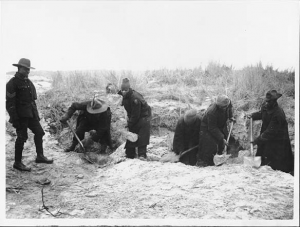In this article Willan focuses on The South African Native Labour Contingent (SANLC), a South African labour force sent to serve in France on behalf of the British Empire during WW1. The article was written in 1978 and can be found in the Journal of African History, Vol. 19.
Black people were recruited to serve under the British military in WW1 as their labour was considered useful on the battlefield. However, they were not allowed to fight in the army as it was believed that black men fighting against/alongside white men would cause problems. Olusoga believes that black people were not allowed to fight against/alongside white men because it would undermine their ‘white prestige’. This fits in with Week 7’s focus on Black people in WW1 as it shows how Africans contributed to British political interests in the 20th century through the roles they performed in the First World War.
The SANLC were focused on aiding the labour shortage at the French ports and at the war front. Their main focus was on manual labour. For example, loading/unloading goods, helping to build roads/railways, quarrying, and forestry.
“splendid reputation for good work under the hardest conditions concievable”
– War Office
Willan argues that the SANLC being recruited to fight in France was a social experiment which allowed the officers to implement strategies of social control on a small scale so that this could be applied to wider society. There was a heavy focus on segregation within the SANLC camps and they were kept under strict control so that they were always under surveillance and were prohibited from mixing with the Europeans. Officers from South Africa were selected to command the SANLC because it was believed that they better understood African mentality and customs which allowed them to keep the men compliant. In addition, six foot fences were placed around the camps to minimise contact with the outisde, and the men were not permitted any alcohol or anything which would encourage reckless behaviour.
Since Europeans were not allowed into the camps and were not permitted to communicate with the natives, Willan argues that this prevented the Africans from developing a sense of entitlement and equality which would have had an effect on political consciousness.

SANLC Members at Work
Willan refrences many different sources in this article ranging from other historians’ publications to official papers. This is useful as it allows the author to draw upon different historical opinion as well as primary evidence in order to effectively illustrate his arguments. There is much reference to the Cape Times. However, as the author mentions in his article, the newspapers often glorified the SANLC and reported little evidence of any unrest or unhappiness among the natives which means that newspaper reports may not be the most reliable form of evidence for reinforcing his arguments.
Overall, the article provides an in-depth analysis of the SANLC and the social conditions in which it existed. Willan makes arguments which are supported by other historians such as Olusoga which shows the integrity of his work. Moreover, the author provides plenty of background information as to why Africans came to join the SANLC which helps put the article into the context of the wider issues Africans faced in the 20th century such as racial prejudice and government instability.
References
Willan, B. P. “The South African Native Labour Contingent 1916-18”. The Journal of African History Vol. 19, No. 1 (1978): 61-86
Olusoga, D. “Black and British : a forgotten history”. London, United Kingdom: Pan Books, 2017.
Thanks Lauren for an interesting analysis of the Willan article. You summarise the gist of the article well. You mention segregation and the use of 6 foot fences to keep the SANLC mixing with locals which is good. There was unrest among the Contingent which you could mention. You might also have mentioned that the ‘experiment’ was ended early partly because the segregation that the SA government desired could not always be kept in place. Avoid using the term ‘natives’ unless you put it in inverted commas – it is seen as a pejorative term today. You make good use of the Olusoga to place the article in the historiography but could also mention what historians Willan himself used.